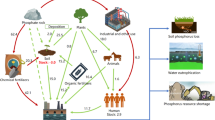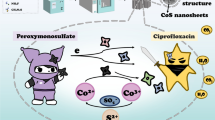Abstract
Although microbially induced calcium carbonate precipitation (MICP) through ureolysis has been widely studied in environmental engineering fields, urea utilization might cause environmental problems as a result of ammonia and nitrate production. In this study, many non-ureolytic calcium carbonate-precipitating bacteria that induced an alkaline environment were isolated from the rhizosphere of Miscanthus sacchariflorus near an artificial stream and their ability to precipitate calcium carbonate minerals with the absence of urea was investigated. MICP was observed using a phase-contrast microscope and ion-selective electrode. Only Lysinibacillus sp. YS11 showed MICP in aerobic conditions. Energy dispersive X-ray spectrometry and X-ray diffraction confirmed the presence of calcium carbonate. Field emission scanning electron microscopy analysis indicated the formation of morphologically distinct minerals around cells under these conditions. Monitoring of bacterial growth, pH changes, and Ca2+ concentrations under aerobic, hypoxia, and anaerobic conditions suggested that strain YS11 could induce alkaline conditions up to a pH of 8.9 and utilize 95% of free Ca2+ only under aerobic conditions. Unusual Ca2+ binding and its release from cells were observed under hypoxia conditions. Biofilm and extracellular polymeric substances (EPS) formation were enhanced during MICP. Strain YS11 has resistance at high pH and in high salt concentrations, as well as its spore-forming ability, which supports its potential application for self-healing concrete.
Similar content being viewed by others
References
Ahmed, I., Yokota, A., Yamazoe, A., and Fujiwara, T. 2007. Proposal of Lysinibacillus boronitolerans gen. nov. sp. nov., and transfer of Bacillus fusiformis to Lysinibacillus fusiformis comb. nov. and Bacillus sphaericus to Lysinibacillus sphaericus comb. nov. Int. J. Syst. Evol. Microbiol. 57, 1117–1125.
Atlas, R.M. 2005. Mineral salts agar, In Handbook of Media for Environmental Microbiology. 2nd ed. CRC Press, Taylor and Francis, New York, USA.
Barabesi, C., Galizzi, A., Mastromei, G., Rossi, M., Tamburini, E., and Perito, B. 2007. Bacillus subtilis gene cluster involved in calcium carbonate biomineralization. J. Bacteriol. 189, 228–235.
Boquet, E., Boronat, A., and Ramos-Cormenzana, A. 1973. Production of calcite (calcium carbonate) crystals by soil bacteria is a general phenomenon. Nature 246, 527–529.
Braissant, O., Cailleau, G., Dupraz, C., and Verrecchia, E.P. 2003. Bacterially induced mineralization of calcium carbonate in terrestrial environments: the role of exopolysaccharides and amino acids. J. Sedimentary Res. 73, 485–490.
Braissant, O., Decho, A.W., Dupraz, C., Glunk, C., Przekop, K.M., and Visscher, P.T. 2007. Exopolymeric substances of sulfate-reducing bacteria: interactions with calcium at alkaline pH and implication for formation of carbonate minerals. Geobiology 5, 401–411.
Dhami, N.K., Reddy, M.S., and Mukherjee, A. 2013. Biomineralization of calcium carbonates and their engineered applications: a review. Front. Microbiol. 4, 314.
Dupraz, C., Reid, R.P., Braissant, O., Decho, A.W., Norman, R.S., and Visscher, P.T. 2009. Processes of carbonate precipitation in modern microbial mats. Earth Sci. Rev. 96, 141–162.
Dupraz, C., Visscher, P.T., Baumgartner, L.K., and Reid, R.P. 2004. Microbe-mineral interactions: early carbonate precipitation in a hypersaline lake (Eleuthera Island, Bahamas). Sedimentology 51, 745–765.
Ehrlich, H.L. 2002. Geomicrobiology. 4th ed. Taylor and Francis, New York, USA.
Ercole, C., Cacchio, P., Botta, A.L., Centi, V., and Lepidi, A. 2007. Bacterially induced mineralization of calcium carbonate: the role of exopolysaccharides and capsular polysaccharides. Microsc. Microanal. 13, 42–50.
Falkowski, P.G., Fenchel, T., and Delong, E.F. 2008. The microbial engines that drive earth’s biogeochemical cycles. Science 320, 1034–1039.
Farhangi, M.B., Safari Sinegani, A.A., Mosaddeghi, M.R., Unc, A., and Khodakaramian, G. 2013. Impact of calcium carbonate and temperature on survival of Escherichia coli in soil. J. Environ. Manage. 119, 13–19.
Ferris, F.G., Stehmeier, L.G., Kantzas, A., and Mourits, F.M. 1997. Bacteriogenic mineral plugging. J. Can. Pet. Technol. 36, 56–61.
Fujita, Y., Ferris, F.G., Lawson, R.D., Colwell, F.S., and Smith, R.W. 2000. Calcium carbonate precipitation by ureolytic subsurface bacteria. Geomicrobiol. J. 17, 305–318.
Gadd, G.M. 2010. Metals, minerals and microbes: geomicrobiology and bioremediation. Microbiology 156, 609–643.
Hamdan, N., Edward K.J., Rittmann, B.E., and Karatas, I. 2011. Carbonate mineral precipitation for soil improvement through microbial denitrification. Geo-Frontiers Congress 2011, 3925–3934.
Hammes, F., Boon, N., De Villiers, J., Verstraete, W., and Siciliano, S.D. 2003. Strain-specific ureolytic microbial calcium carbonate precipitation. Appl. Environ. Microbiol. 69, 4901–4909.
Hammes, F. and Verstraete, W. 2002. Key roles of pH and calcium metabolism in microbial carbonate precipitation. Rev. Environ. Sci. Biotechnol. 1, 3–7.
Hazen, R.M., Papineau, D., Bleeker, W., Downs R.T., Ferry, J.M., McCoy, T.J, Sverjensky, D.A., and Yang, H. 2008. Mineral evolution. Am. Mineral. 93, 1693–1720.
Kim, H.J., Eom, H.J., Park, C., Jung, J., Shin, B., Kim, W., Chung, N., Choi, I.G., and Park, W. 2016a. Calcium carbonate precipitation by Bacillus and Sporosarcina strains isolated from concrete and analysis of the bacterial community of concrete. J. Microbiol. Biotechnol. 26, 540–548.
Kim, J.G., Park, S.J., Damstéc, J.S.S., Schoutenc, S., Rijpstra, W.I.C., Jung, M.Y., Kima, S.J., Gwaka, J.H., Honga, H., Sia, O.J., et al. 2016b. Hydrogen peroxide detoxification is a key mechanism for growth of ammonia-oxidizing archaea. Proc. Natl. Acad. Sci. USA 113, 7888–7893.
Mishra, V. 2015. Modelling of the batch biosorption system: study on exchange of protons with cell wall-bound mineral ions. Environ. Technol. 36, 3194–3200.
Nolan, R.A. 1971. Amino acids and growth factors in vitamin-free casamino acids. Mycologia 63, 1231–234.
Park, S.J., Park, Y.M., Chun, W.Y., Kim, W.J., and Ghim, S.Y. 2010. Calcite-forming bacteria for compressive strength improvement in mortar. J. Microbiol. Biotechnol. 20, 782–788.
Phillips, A.J., Gerlach, R., Lauchnor, E., Mitchell, A.C., Cunningham, A.B., and Spangler, L. 2013. Engineered applications of ureolytic biomineralization: a review. Biofouling 29, 715–733.
Priest, F.G., Goodfellow, M., and Todd, C. 1988. A numerical classification of the genus Bacillus. J. Gen. Microbiol. 134, 1847–1882.
Reeburgh, W.S. 2007. Oceanic methane biogeochemistry. Chem. Rev. 107, 486–513.
Riding, R. 2000. Microbial carbonates: the geological record of calcified bacterial-algal mats and biofilms. Sedimentology 47, 179–214.
Rodriguez-Navarro, C., Rodriguez-Gallego, M., Ben Chckroun, K., and Gonzalez-Munoz, M.T. 2003. Conservation of ornamental stone by Myxococcus xanthus-induced carbonate biomineralization. Appl. Environ. Microbiol. 69, 2182–2193.
Seifan, M., Samani, A.K., and Berenjian, A. 2017. New insights into the role of pH and aeration in the bacterial production of calcium carbonate (CaCO3). Appl. Microbiol. Biotechnol. 101, 3131–3142.
Shirakawa, M.A., Cincotto, M.A., Atencio, D., Gaylarde, C.C., and John, V.M. 2011. Effect of culture medium on biocalcification by Pseudomonas putida, Lysinibacillus sphaericus and Bacillus subtilis. Braz. J. Microbiol. 42, 499–507.
Silva, F.B., Boon, N., De Belie, N., and Verstraete, W. 2015. Industrial application of biological self-healing concrete: challenges and economical feasibility. J. Commer. Biotechnol. 21, 31–38.
Thomas, K.J. and Rice, C.V. 2014. Revised model of calcium and magnesium binding to the bacterial cell wall. Biometals 27, 1361–1370.
Van Paassen, L.A., Daza, C.M., Staal, M., Sorokin, D.Y., Van Der Zon, W., and Van Loosdrecht, M.C. 2010. Potential soil reinforcement by biological denitrification. Ecol. Eng. 36, 168–175.
Wan, S., Li, G., An, T., Guo, B., Sun, L., Zu, L., and Ren, A. 2010. Biodegradation of ethanethiol in aqueous medium by a new Lysinibacillus sphaericus strain RG-1 isolated from activated sludge. Biodegradation 21, 1057–1066.
Wang, J., Ersan, Y.C., Boon, N., and Belie N.D. 2016. Application of microorganisms in concrete: a promising sustainable strategy to improve concrete durability. Appl. Microbiol. Biotechnol. 100, 2993.
Warren, L.A. and Ferris, F.G. 1998. Continuum between sorption and precipitation of Fe (III) on microbial surfaces. Environ. Sci. Technol. Lett. 21, 2331–2337.
Warren, L.A., Maurice, P.A., Parmar, N., and Ferris, F.G. 2001. Microbially mediated calcium carbonate precipitation: implications for interpreting calcite precipitation and for solid-phase capture of inorganic contaminants. Geomicrobiol. J. 18, 93–115.
Zhu, T. and Dittrich, M. 2016. Carbonate precipitation through microbial activities in natural environment, and their potential in biotechnology: a review. Front. Bioeng. Biotechnol. 4, 4.
Author information
Authors and Affiliations
Corresponding author
Rights and permissions
About this article
Cite this article
Lee, Y.S., Kim, H.J. & Park, W. Non-ureolytic calcium carbonate precipitation by Lysinibacillus sp. YS11 isolated from the rhizosphere of Miscanthus sacchariflorus . J Microbiol. 55, 440–447 (2017). https://doi.org/10.1007/s12275-017-7086-z
Received:
Revised:
Accepted:
Published:
Issue Date:
DOI: https://doi.org/10.1007/s12275-017-7086-z




